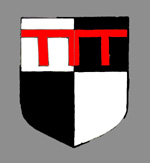The Troubles of Sir Richard Conquest

Conquest family arms
In 1634 Sir Richard Conquest became Lord of the Manor of Houghton Conquest alias Conquest Bury, which had been held by his family for around four hundred years. Volume III of the Victoria County History for Bedfordshire gives details of the problems which were later to befall him. His story is also related by Ross Lee in Volume 65 of Bedfordshire Historical Record Society, published in 1986, Law and Local Society in the Time of Charles I: Bedfordshire and the Civil War.
Born in 1597, Sir Richard was unusual amongst Bedfordshire gentry in being a recusant, that is, a Roman Catholic. He married Elizabeth Thimelby of Irnham [Lincolnshire], daughter of another Catholic family, in 1626. His wife’s sister was a nun in Louvain and his wife was a lady of the Bedchamber of the Catholic Queen Henrietta Maria in 1634. Sir Richard and his wife were both indicted as recusants in London in 1640. The price he had to pay was £20 per month on the income of two-thirds of his estates. This, together with the large size of his extended family (his father had sired twenty children) rendered Sir Richard somewhat impoverished.
Given all this it is not, therefore, surprising that on the outbreak of the English Civil War in 1642 Sir Richard declared for King Charles I (1625-1649) and became a colonel in the Royalist army. Charles, Head of the Church of England, was married to a Catholic and was felt to have Catholic sympathies. Of course, Sir Richard was on the losing side, the first civil war ending in Royalist defeat in 1646. In 1644 Sir Richard’s estate was seized by parliament and it seems that he spent part of 1645 in prison for debt.
In 1648 he paid his fine and had his estates restored so his troubles might have been seemed to be easing. 1650, however, was a bad year. The new minister of Houghton Conquest, Samuel Fairclough, was a puritan and in that year denounced Sir Richard as “most dangerous, malignant and papist” and stated that his estate had been undervalued when he paid his fine in 1648, being worth £800 a year. This led to its being seized once more. Sir Richard pleaded that the previous seizure had left insufficient substance for himself, his wife, eight sons and five servants as well as for the maintenance of two brothers and two sisters. In 1651 his case was heard in London and his estates were released to him. However, as he was leaving court he was arrested on a charge of having beaten and wounded an officer and his men who had been sent to take him into custody the previous year. Fortunately for him he was soon released.
The following year he petitioned against his son-in-law, Francis Theobald. Theobald had taken possession of Sir Richard’s estate. Again, the estate was restored. Sir Richard’s troubles might have ended with the restoration of Charles II in 1660. In that year he had the pleasure of seeng Samuel Fairclough ejected from the living at Houghton Conquest where he was held to have intruded illegally. However, in 1661 he had to bring an action against the mother of his grandson Richard because Richard's father, now deceased and also called Richard, seems to have claimed a significant part of his father's estates by stealing legal documents. Whether Sir Richard had any peace in his final years cannot be known but, given his combative character it seems unlikely, certainly one cannot see the rift with his grandson being easily healed! Sir Richard died in 1671.